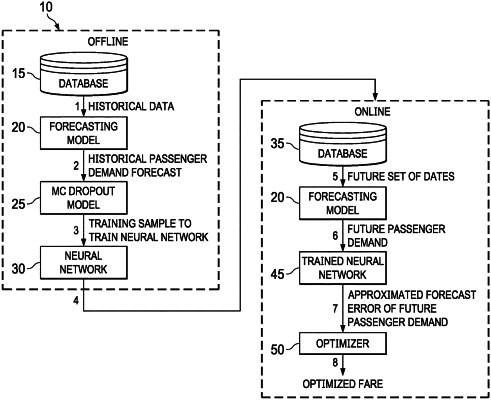| CPC G06Q 10/06315 (2013.01) [G06N 3/045 (2023.01); G06Q 10/04 (2013.01); G06Q 30/0206 (2013.01)] | 20 Claims |

|
11. A system for training a neural network to approximate a forecasting error of a passenger-demand forecasting model, the system comprising a non-transitory computer readable medium having stored thereon a plurality of instructions, wherein the instructions are executed with one or more processors so that the following steps are executed:
calculating, using the forecasting model, a historical passenger demand forecast for each key level in a set of key levels and for each departure date in a first set of departure dates;
wherein the forecasting model is an integrated model that comprises:
a convolutional neural network (“CNN”) model;
a long short-term memory (“LSTM”) model;
wherein the LSTM model is a recurrent neural network;
and
a convolutional LSTM model that integrates the CNN model and the LSTM model together in one architecture
wherein each key level in the set of key levels is associated with a unique product for which demand is being forecasted; and
wherein the first set of departures dates are historical departures dates; and
applying a dropout model to the historical passenger demand forecasts to create a training sample;
training, using the historical passenger demand forecasts and the training sample, the neural network, to approximate forecasting errors associated with the forecasting model;
calculating, using the forecasting model, a future passenger demand forecast for each key level in the set of key levels and for each departure date in a second set of departure dates;
wherein the second set of departures dates are future dates;
wherein each departure date of the second set of departure dates is associated with a plurality of forecast periods;
wherein each forecast period of the plurality of forecast periods is associated with a period of time before departure;
wherein each departure date of the second set of departure dates is associated with a plurality of fare products;
wherein each fare product of the plurality of fare products is a marketable combination of access rights associated with a charging moment;
wherein the CNN model captures, for each departure date of the second set of departure dates and for each forecast period from the plurality of forecasts periods on a given departure date, a booking relationship between the plurality of fare products;
wherein the LSTM model models a time series that is a temporal correlation, across the departure dates of the second set of departure dates, of the booking relationships;
wherein calculating, using the forecasting model, the future passenger demand forecast for each key level in the set of key levels and for each departure date in the second set of departure dates comprises:
applying a convolutional feature extractor on input data of the CNN model;
wherein the input data comprises historical fractional closures for each fare product of the plurality of fare products;
running the CNN model using the input data of the CNN model to create output(s) of the CNN model; and
running the LSTM model using input data of the LSTM model to create LSTM model output(s);
wherein input data of the LSTM model comprises:
the output(s) of the CNN model; and
features used to model seasonality; and
wherein the output(s) of the LSTM model comprise predicted bookings with consideration of cancellation probabilities;
and
approximating, using the trained neural network, the forecasting error associated with the future passenger demand forecasts for the second set of departure dates.
|